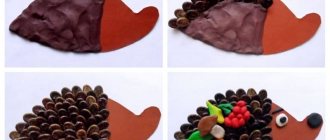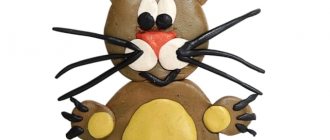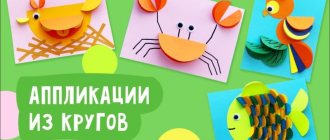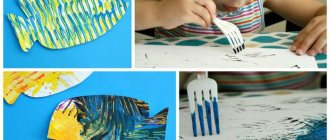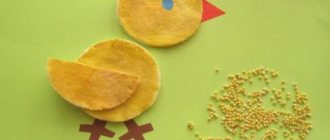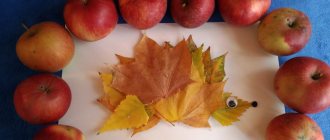These funny animals
Children are keenly interested in animals: they surround them at home, they appear in books and cartoons, so it will not be difficult for an adult to explain and show a child how to make animals from plasticine.
Modeling such figures is a labor-intensive process, but with due diligence the result will not disappoint and will instill in the child confidence in his abilities. So, we sculpt animals from plasticine.
Birds
Sculpting birds is quite difficult, but you can try to make a white swan:
- A body with an elongated tail is sculpted from an oval.
- Attached to the sides are two flat, smaller ovals, pointed at one end - wings.
- The long piece is used to make a curved neck and a larger head.
- Eyes are made on the head, the beak is made from a small piece of red color.
If you take black plasticine, you will get a swan of a rare shade.
Lesson 19. Sheep (Decorative clay plate)
Program content. Teach children to depict the relief of an animal in the form of a decorative plate. Learn to trace a template with a stack and use it to remove excess clay. Continue to learn how to independently bring a product to the intended image using various tools. Develop imaginative thinking.
Material. Subject picture with a sheep. Clay, sheep silhouette templates, rolling pins, spade rolls, felt-tip pen caps, bowls of water, cardboard stands, modeling boards (for each child).
Cartoon characters
Peppa Pig is a popular pig from the children's cartoon and a good exercise for developing motor skills:
- Two balls are molded - pink and red.
- The pink ball is given the shape of a head with an elongated snout, and the red one should make a dress with a hem, the resulting parts are connected.
- Two thin arms, two thicker legs and a curled tail are sculpted from pink plasticine.
- Two pink ears are attached to the head, white eyes with black pupils, and the snout, cheeks and mouth are made of dark pink so that they stand out.
Making your own favorite cartoon character with so many small details is a real achievement and creative success for a child.
Crafts from photography
If you have a photo of a craft made by a specific animal, for example, from a book or the Internet, you can try to make the figurine you like with your child. It could be a panda - a cute two-colored bear. The panda has many elements:
- A white head with a small white muzzle and a black nose, black circles around the eyes, white eyes and black pupils, and black round flat ears on top.
- One elongated part is made from black plasticine - the upper part of the body plus two legs on the sides.
- An oval white part is attached below - this is the lower part of the body.
- Finally, two small black balls are attached to the lower white part of the body - the second pair of paws.
This is a complex figure due to the abundance of elements, but the result will please you.
Pets: how to make a dachshund, cat, cow, pig
Plasticine animals can be very funny and bright. The process of making them is always accompanied by positive emotions. Even pet animals made from this material become an excellent decoration for a child’s room.
Plasticine dachshund
In order to make such a dog, you just need to follow the diagram exactly:
- Roll the black mass into a ball and stretch it out into a long, narrow droplet shape. This part will later become the body of the dog.
- From the wide side, lift the part up.
- Apply the brown mass to the abdomen in an even layer.
- Form a small protrusion - you get a neck.
- To make a head, you need to roll a black and brown ball.
- Extend the black element into the shape of a drop, then stick the brown part to its lower part and extend it a little.
- Using your finger, pull the black material a little onto the nose and highlight the eyes with a stack.
- Now add the pupils and form the ears.
- Attach the head to the neck using a match.
- Make the upper parts of the paws from black material and attach brown elements to the bottom.
- Attach the legs to the body.
- Roll up a thin tube and stick to the abrasions, lifting them up a little.
How to blind a cat
If you follow simple instructions, you will be able to quickly and easily make a funny cat - one of the most beloved pets.
If you follow simple instructions, you can quickly and easily make a funny cat
Progress:
- Using a stack, divide the block of plasticine into three equal parts.
- Roll two parts into balls, and divide the third into six more parts.
- Roll four small pieces into sausages for future legs.
- Roll another small piece a little thinner to make a tail.
- Divide the remaining small part into a couple more identical pieces and make ears from them.
- Form the head and body, then connect these two elements with a match.
- Attach the tail and legs to the body.
Blind the eyes and tongue.
Cow: how to make it with your own hands
The cow sculpting scheme is quite simple and comes down to the following steps:
:
- Roll the brown and orange material into balls and connect them together.
- Attach the eyes, make slits in the form of nostrils, and make a smile with stacks.
- Make horns and attach them to the head.
- Attach ears to the future cow.
- Make an oval out of the brown mass and squeeze it a lot, stretching the neck.
- Make legs and attach hooves made of gray material to them.
- Make an udder from the beige mass.
- Make a tail and then connect all the parts.
Piggy: modeling in stages
This funny pig is easy and quick to make. You just need to strictly follow the instructions:
- Shape the body into a barrel shape.
- Roll four balls and attach them to the body.
- Roll another, but larger ball and also attach it to the body.
- Form a snout and ears.
- Use a match to draw the nostrils and eyes.
Plasticine animals can be very funny and bright
Attach a ponytail wrapped with a crochet hook.
Choosing plasticine
When purchasing plasticine, you need to carefully read the instructions from the manufacturer and make sure that it is appropriate for the child’s age and suitable for modeling purposes.
Classic hard plasticine is a durable material, crafts made from which are durable, but this property can also be a disadvantage, since very young children may not be able to handle it.
Light plasticine is a soft, bright material with natural dyes, easy to clean, suitable for children of any age;
The modeling compound is a very practical and easy-to-use material, it doesn’t stick, it retains its plasticity for 12 hours; the downside is the high price.
Ball plasticine is an excellent material for small children’s hands; it is often used for additional decoration of ready-made figures; it is fragile, but due to its characteristics, the child must be under the constant supervision of adults while sculpting.
Floating plasticine will give children a lot of pleasure, as it is soft, does not stain hands and clothes, and figures made from it float on the water.
Modeling paste - resembles clay, ideal for creating solid figures, since parts made from paste do not stick to each other, suitable for painting.
Thus, for playing with children, it is better to take light plasticine in bright colors, as well as hard material to create more durable and long-lasting crafts. You should not choose sets with strong flavors and artificial colors - they can cause allergies.


